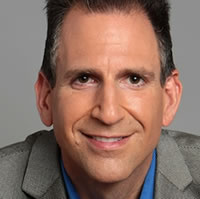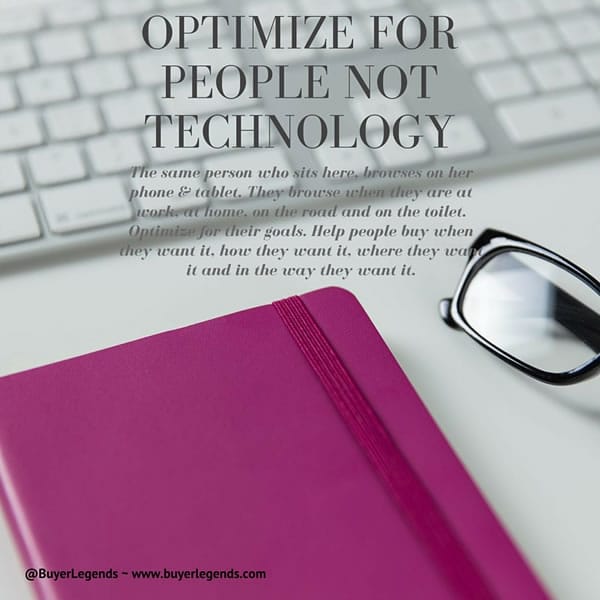Marketers always had a tendency to optimize for channels, media and the technologies they used. Up until the arrival of tools to optimize for journeys, touchpoints and individual experiences it was hard to do otherwise.

Yet, in practice optimizing for technology is still too often the focal point, even as marketing optimization is more about personalization and optimization for people than ever before. There is obviously a whole new range of technologies, from data-driven solutions to advanced audience ‘targeting’ and real-time personalization depending on actual behavior but that’s not what I’m talking about. What I am talking about is context and a ‘people first’ approach.
Optimization amid rapidly changing expectations and expanded choices
In more than one way and, even with increasing marketing optimization and personalization possibilities, optimization has become more complex. The idea that we optimize for people instead of for media, channels, technologies and so on isn’t really that new. Just think about how smart marketing optimization experts looked at the overall journey and experience of the search engine user in the scope of an intent, a task and a consecutive series of actions (and micro-conversions) that starts before even typing in a keyword and ends after having clicked a search engine result and, in the end, finalizing or stopping the intent for which the search was conducted to begin with.
Still, it’s more important than ever to optimize with the individual user in mind because the context has become so much more important and complex. People do expect more. Just look at how changing customer expectations have changed the face of retail, transformed how we do business with banks or want to be approached as “empowered” citizens.
Add to that the explosion of devices, increasing connectedness, huge mobile abilities and ever more ways and forms to access the Internet (the smartphone is certainly not the end of our mobile ability and our connectivity possibilities, one day it will be a very old relic too).
Optimizing for people and their context
In a way we could say we have moved faster than before from a need to optimize and personalize for people to a need to optimize for the specific context within which the individual performs a task.
Think about that search engine user again. Do we really know his or her intent? What devices are they using to search anything? When and where are they using that device? These seemingly small details all matter. Sure, you can’t know everything. You also don’t need to know everything to be relevant and you certainly don’t want marketers to know everything. I personally wouldn’t be very happy if Google ‘knew’ I was searching or browsing on my smartphone while sitting in a, let’s say, very private place.
Earlier this Summer I had a call with our friend Bryan Eisenberg and we talked, among other things, about all these evolutions and challenges. Bryan wrote a post about part of the discussion just before: “Optimize for people, not for technology”. It is the only constant that never changes, he added.
What goes for marketing optimization goes for optimization overall. People first, technology next. Bryan’s post was little more than a few lines and an image with more lines that say enough so I’m sharing it here with you too. My guess is he also browses and searches the Web on the toilet by the looks of it (OK, I admit, we talked about it).

Here is a thought: what if optimizing for people and for technology could coiincide? Often we try to do just that, dont’ we?
What if optimizing any technological project, process, activity or ‘experience’ was ultimately measured by how it optimizes for people? And what if we really looked at digital transformation, digitization and technology as such as ultimately ways to optimize for people on their terms: how, where and when they want it. And, thinking about that toilet and the ways we can leverage data, also how they DON’T want it.
People first: a continuous effort of optimizing – and understanding
In the end marketing optimization, digital transformation, customer experience optimization and all these efforts we do should in the end help people accomplish their goals in today’s hyper-connected reality whereby everything, almost every single process is interconnected, in and far beyond marketing. Holistic optimization.
Because that, to me, is one of the key aspects of digital transformation: the interconnectedness of optimization, far beyond any function or department and with a common goal in mind. Like optimizing for people, for instance, so they get the end-to-end quality they deserve when doing the trouble to find us and work with us (and bring in the money so we can pay the bills).
Do we achieve it? No. After all this time we’re even still not looking at search engine marketing from an integrated people and relevance perspective. But then again, optimization is a continuous journey: we listen, watch, learn, detect, prioritize, decide and continuously try harder.
Again, as Bryan says: “In order to future proof your optimization efforts, remember the focus should be on the people not the technology. That is the one constant that never changes. Our job is to help people buy no matter where they are, what device they use, if they browse by mouse, touch or voice”.
You can take it a step further and look at it as an ongoing leitmotiv in everything you do as marketer but also as a CIO, a C-level exec, a CX expert, a contact center agent, a knowledge worker, an information manager and, in the end, just a human being like your customers. Understand, optimize, measure, correct and add another piece, each time a bit more contextually relevant.
People first is always a good mantra as long as their goals are worth optimizing for. But that’s another discussion.

A bit of context: this quick post was not written during a visit at the toilet but after a silent moment of watching the sunset. In the meantime I can see the stars outside.
Toilet smartphone image: Shutterstock – Copyright: nito

